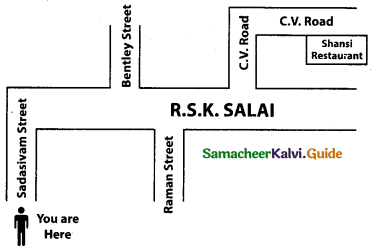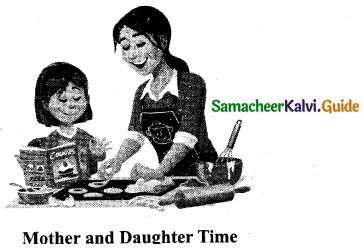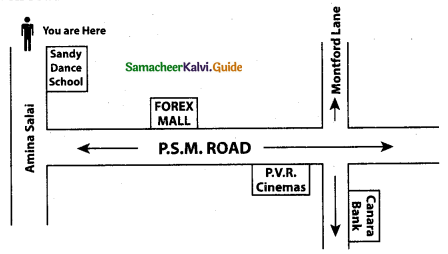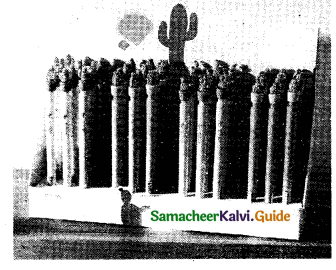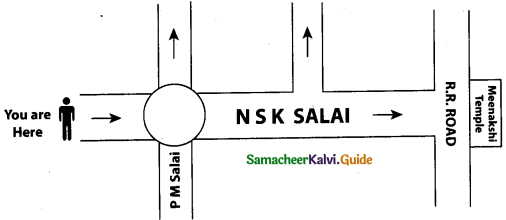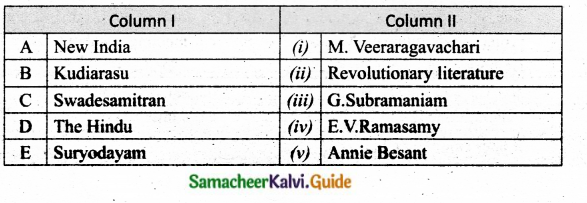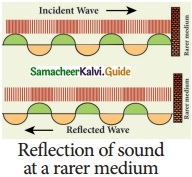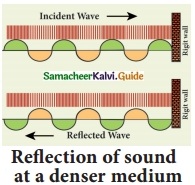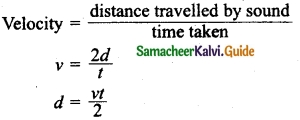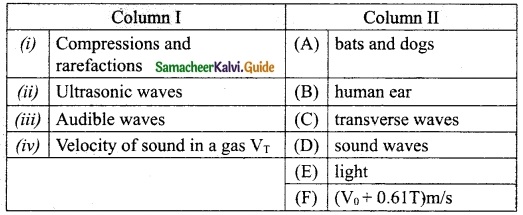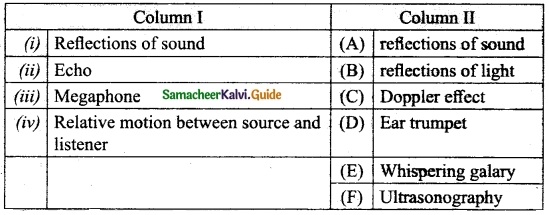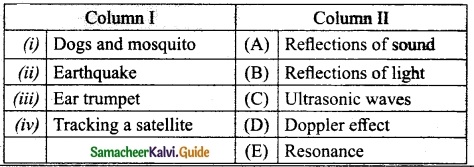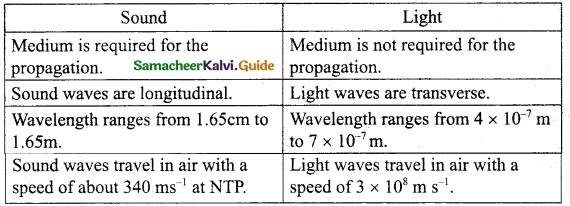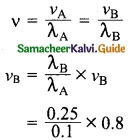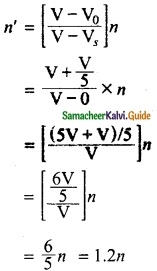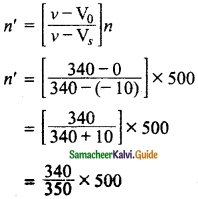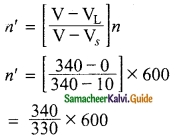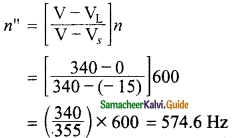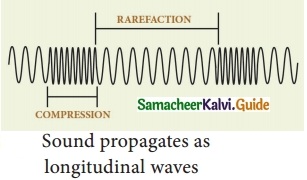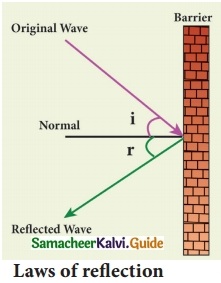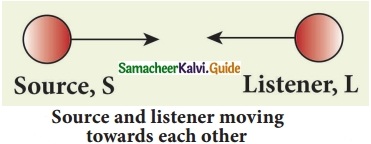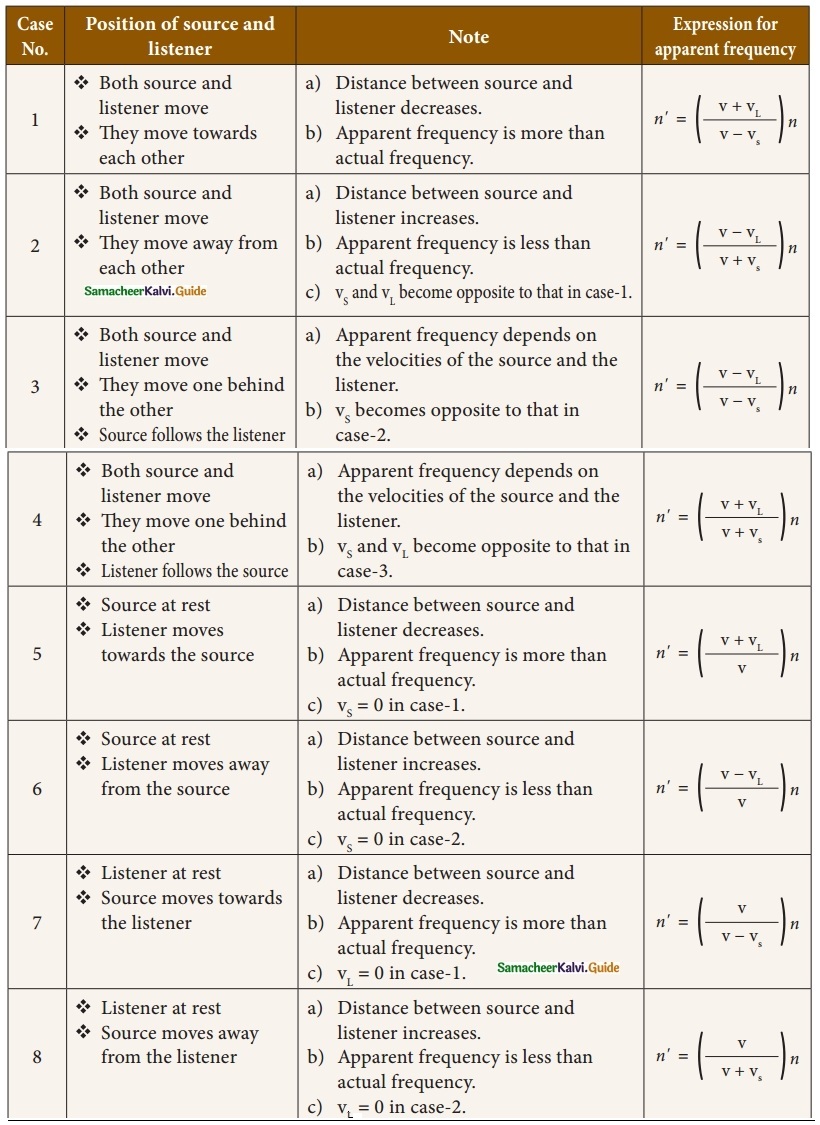Students can download 10th Social Science History Chapter 8 Nationalism: Gandhian Phase Questions and Answers, Notes, Samacheer Kalvi 10th Social Science Guide Pdf helps you to revise the complete Tamilnadu State Board New Syllabus, helps students complete homework assignments and to score high marks in board exams.
Tamilnadu Samacheer Kalvi 10th Social Science Solutions History Chapter 8 Nationalism: Gandhian Phase
Samacheer Kalvi 10th Social Science Nationalism: Gandhian Phase Text Book Back Questions and Answers
I. Choose the correct answer
Question 1.
Who was arrested during the anti*Rowlatt protests in Amritsar?
(a) Motilal Nehru
(b) Saifuddin Kitchlew
(c) Mohamed Ali
(d) Raj Kumar Shukla
Answer:
(b) Saifuddin Kitchlew
Question 2.
In which session of the Indian National Congress was Non-Cooperation approved?
(a) Bombay
(b) Madras
(c) Lucknow
(d) Nagpur
Answer:
(d) Nagpur
![]()
Question 3.
Which among the following was declared as ‘Independence Day’?
(a) 26th January 1930
(b) 26th December 1929
(c) 16th June 1946
(d) 15th January 1947
Answer:
(a) 26th January 1930
Question 4.
When was the first Forest Act enacted?
(a) 1858
(b) 1911
(c) 1865
(d) 1936
Answer:
(c) 1865
Question 5.
On 8 January 1933 which day was observed
(a) Temple Entry Day
(b) Day of Deliverance
(c) Direct Action Day
(d) Independence Day
Answer:
(a) Temple Entry Day
Question 6.
Which Act introduced Provincial Autonomy?
(a) 1858 Act
(b) Indian Councils Act, 1909
(c) Government of India Act, 1919
(d) Government of India Act, 1935
Answer:
(d) Government of India Act, 1935
Question 7.
Who defeated Pattabhi Sitaramaya, Gandhi’s candidate, and became the President of the Congress in 1939?
(a) Rajendra Prasad
(b) Jawaharlal Nehru
(c) Subhas Chandra Bose
(d) Maulana Abul Kalam Azad
Answer:
(c) Subhas Chandra Bose
Question 8.
Where was Gandhi when India attained independence on 15th August 1947?
(a) New Delhi
(b) Ahmedabad
(c) Wardha
(d) Noakhali
Answer:
(d) Noakhali
II. Fill in the blanks
- Gandhi was thrown out of the first class compartment in ………………… station.
- Gandhi regarded ………………… as his political guru.
- Khilafat Movement was led by …………………
- Government of India Act 1919 introduced ………………… in the provinces.
- The Civil Disobedience Movement in North West Frontier Province was led by …………………
- Ramsay Macdonald announced ………………… which provided separate electorates to the minorities and the depressed classes.
- ………………… established Congress Radio underground during the Quit India Movement.
- ………………… coined the term ‘Pakistan’.
Answers:
- pietermaritzburg
- Gopal Krishna Gokhale
- Ali brothers
- dyarchy
- Khan Abdul Ghaffar Khan
- Communal award
- Ushamehta
- RahmatAli
![]()
III. Choose the correct statement
Question 1.
(i) The Communist Party of India was founded in Tashkent in 1920.
(ii) M. Singaravelar was tried in the Kanpur Conspiracy Case.
(iii) The Congress Socialist Party was formed by Jayaprakash Narayah, Acharya Narendra Dev and Mino Masani.
(iv) The Socialists did not participate in the Quit India Movement.
(a) (i) and (ii) are correct
(b) (ii) and (iii) are correct
(c) (iv) is correct
(d) (i), (ii) and (iii) are correct
Answer:
(d) (i), (ii) and (iii) are correct
Question 2.
(i) Hindustan Republican Army was formed in Kanpur in 1924.
(ii) Ram Prasad Bismil was tried in the Kakori Conspiracy Case.
(iii) Hindustan Socialist Republican Association was formed by Surya Sen.
(iv) Chittagong Armoury Raid was carried out by B.K. Dutt.
(a) (i) and (ii) are correct
(b) (i) and (iii) are correct
(c) (iii) is correct
(d) (iii) and (iv) are correct
Answer:
(a) (i) and (ii) are correct
Question 3.
Assertion: The Congress attended the First Round Table Conference. Reason: Gandhi-lrwin Pact enabled the Congress to attend the Second Round Table Conference.
(a) Both A and R are correct but R is not the correct explanation of A.
(b) A is correct but R is wrong.
(c) A is wrong but R is correct.
(d) Both A and R are correct and R is the correct explanation of A.
Answer:
(c) A is wrong but R is correct.
![]()
Question 4.
Assertion: The Congress Ministries resigned in 1939.
Reason: The Colonial government of India entered the war without consulting the elected Congress ministries.
(a) Both A and R are correct but R is not the correct explanation of A.
(b) A is correct but R is wrong.
(c) Both A and R are wrong.
(d) Both A and R are correct and R is the correct explanation of A.
Answer:
(d) Both A and R are correct and R is the correct explanation of A.
IV. Match the following

Answer:
A. (v)
B. (i)
C. (ii)
D. (iii)
E. (iv)
V. Answer the following briefly
Question 1.
Describe the Jallianwala Bagh Massacre.
Answer:
On 13 April 1919, a public meeting was organised at Jallianwala Bagh in Amritsar in defiance of the Rowlatt Act. As it happened to be Baisaki Day, thousands of villagers had gathered there to enjoy the day together. General Reginald Dyer, on hearing the assemblage, surrounded the place with his troops and an armoured vehicle. He blocked the only entrance to the park and ordered his troops to fire without any warning. The firing continued for ten minutes in which about 370 were killed and more than thousand injured. However, an unofficial estimates put the death toll at more than thousand. The Jallianwala Bagh massacre is a big scar on the British Indian history.
Question 2.
Write a note on the Khilafat Movement.
Answer:
- After the end of first World war in 1918 Caliph the Muslim head in Turkey was ill treated.
- A movement was started his support Khilafat movement led by the Ali brothers, Maulana Mohamed Ali and Maulana Shaukat Ali.
- It aimed to restore the prestige and power of the Caliphate.
- Gandhiji saw Khilafat movement as an opportunity to unite Hindus and Muslims.
- On 9th June 1920 the Khilafat committee in Allahabad adopted Gandhi’s non – violent, non – co-operation programme.
Question 3.
Why did Gandhi withdraw the Non-Cooperation Movement?
Answer:
The Non-cooperation Movement started in 1920. It soon became a nation-wide movement because it got support from the people across the country. But in February 1922, a violent incident occurred at Chauri Chaura, a village near Gorakhpur in Uttar Pradesh. In this incident a procession of nationalists provoked by the police turned violent. The police finding themselves outnumbered shut themselves inside the police station. The mob burnt the police station in which 22 policemen lost their lives. The incident hurt Gandhiji too much and he immediately withdrew the movement.
Question 4.
What was the conflict between the Swarajists and no-changers?
Answer:
The pro – changers (Swarajis) led by motilal Nehru and C.R. Das were the congressmen who wanted to contest the elections and enter the legislature.
They argued that the national interest could be promoted by working in the legislative councils under Dyarchy and the colonial Government could be wrecked within.
But on the other hand the followers of Gandhiji (no – changers) like Patel and C. Rajaji wanted to continue Non – Cooperation with the Government.
This was the conflict between the Swarajis and the no – changers.
Question 5.
Why was Simon Commission boycotted?
Answer:
On 8 November 1927, the British Government announced the appointment of the Indian Statutory Commission. It was composed of seven members headed by Sir John Simon which came to be known as the Simon Commission. When the Simon Commission arrived in India in 1928, millions of Indians were infuriated with the idea of an all- British committee writing proposals for Indian constitutional reforms without any member or consultations with the people of India. The Commission was, therefore, boycotted everywhere. Holding black flag in their hands the protesters shouted, “Go back Simon”.
![]()
Question 6.
What is Poorna Swaraj?
Answer:
- In the congress session held in Lahore in December 1929 with Jawaharlal Nehru as the president declared “Poorna Swaraj” (complete independence) as the goal.
- To attain Poorna Swaraj it was decided to boycott the round Table conference and launch a Civil Disobedience Movement.
- 26th January 1930 was declared as Independence Day.
- A pledge was taken all over the country to attain ‘Poorna Swaraj’ non – violently.
Question 7.
Write a note on Bhagat Singh.
Answer:
Bhagat Singh was an Indian socialist revolutionary whose two acts of dramatic violence against the British in India and the execution at the age of 23 made him a folk hero of the Indian Independence Movement. Bhagat Singh along with B. K. Dutt threw a smoke bomb inside the Central Legislative Assembly in 1929.
It was not intended to hurt anyone. They threw pamphlets and shouted ‘Inquilab Zindabad’ and ‘Long Live the Proletariat’. He along with Rajguru was arrested and sentenced to death. Bhagat Singh’s daring act fired the imagination of the youth across India and he became popular.
Question 8.
What are the terms of the Poona Pact?
Answer:
An agreement arrived between Gandhiji and Ambedkar came to be known as ‘Poona pact’. It’s main terms were.
- Principle of joint electorate was accepted with reservation of seats for the depressed classes.
- Number of seats allotted has increased from 71 to 148.
- In the central legislature 18% of the seats were reserved for the depressed classes.
VI. Answer all the questions given under each caption
Question 1.
Gandhi and Mass nationalism.
(a) Which incident is considered a turning point in the life of Gandhi?
Answer:
On his journey from Durban to Pretoria, at the Pietermaritzburg railway station, he was physically thrown out of the first-class compartment in which he was travelling despite having a first class ticket. This incident is considered a turning point in the life of Gandhi.
(b) Name the works that influenced Gandhi?
Answer:
Tolstoy’s The Kingdom of God is Within You, Ruskin’s Unto This Last and Thoreau’s Civil Disobedience.
(c) How did Gandhi use satyagraha as a strategy in South Africa?
Answer:
Gandhi developed satyagraha (truth-force) as a strategy, in which campaigners went on peaceful marches and presented themselves for arrest in protest against unjust laws.
(d) What do you know about the Champaran Satyagraha?
Answer:
The Champaran Satyagraha of 1916 was the first satyagraha movement inspired by Gandhi. It was a farmer’s uprising that took place in Champaran district of Bihar, India during the British colonial period.
Question 2.
Constructive Programme of Gandhi
(a) What is constructive programme?
Answer:
After the chauri chaura incident, Gandhiji felt that the volunteers and the people had to be trained for a non – violent struggle, and take up in hand the youth of the country and make them the real soldiers of Swaraj. This is the constructive programme, Gandhiji wanted to implement. More over he focussed on promoting khadhi, Hindu – Muslim unity and the abolition of untouchability.
(b) What did Gandhi exhort the Congressmen to do?
Answer:
He exhorted the congressmen to go throughout their districts and spread the message of Khaddar, Hindu – Muslim unity and anti – untouchability.
(c) How did Gandhi try to bring about Hindu-Muslim unity?
Answer:
Gandhiji undertook a 21 days fast in between 1924 to appeal to the hearts of the Hindus and Muslims involved in communal politics.
(d) What is the contribution of Gandhi towards abolition of untouchability?
Answer:
Gandhiji made his life’s mission to wipe out untouchability. He sought to abolish the pernicious custom of untouchability not the caste system. He undertook an all India tour called the Harijan (Children of God) Tour.
- He started the “Harijan Sevak Sangh’ to work for the removal of discrimination.
- He worked to promote education, cleanliness and hygiene and giving up of liquour among the depressed class.
- He also undertook two fasts in 1933 for this cause.
- An important part of his campaign was the ‘Temple Entry Movement”.
- He took the message of Nationalism to the grass roots by his work among the depressed classes and tribals.
Question 3.
Subash Chandra Bose and INA
(a) How did Subhas Chandra Bose reach Japan?
Answer:
First he went to Germany, from there he made his way to Japan on a submarine and took control of the Indian National Army.
(b) Who headed the women wing of Indian National Army?
Answer:
Lakshmi Sahgal headed the women wing of the Indian National Army.
(c) How did Subash Chandra Bose reorganize the INA?
Answer:
Bose reorganised the INA into three brigade: Gandhi Brigade, Nehru Brigade and a women’s brigade named after Rani Lakshmi Bai.
(d) Name the slogan provided by Subash Chandra Bose.
Answer:
He gave the slogan ‘Dilli Chalo’.
![]()
VII. Answer in detail
Question 1.
Examine the factors that led to the transformation of Gandhi into a mass leader.
Answer:
The factors that led to the transformation of Gandhiji into a mass leader are given below:
(i) Mahatma Gandhi arrived in India in 1915 from South Africa after fighting for the civil rights of the Indians therefor about twenty years. He brought with him a new impulse to Indian politics.
(ii) He introduced a new instrument Satyagraha, which he had perfected in South Africa, that could be practiced by men and women, young and old. As a person dedicated to the cause of the poorest of the poor, he instantly gained the goodwill of the masses.
(iii) Unlike the constitutionalists who appealed to the British sense of justice and the militants who confronted the repression of the colonial state violently, Gandhiji adopted non-violent methods to mobilize the masses and mount pressure on the British.
(iv His Champaran Satyagraha of 1916 earned immense success. This followed by his fruitful intervention in the Ahmedabad mill strike and the Kheda Satyagraha in 1918. These factors helped Gandhiji establish as a leader of mass struggle.
(v) The people from across the country began to support him whole-heartedly. They found in him all the qualities of a mass leader. So, they loved him and were ready to do what he said. They showed immense faith in him because they were sure Gandhiji would bring freedom for them.
Question 2.
Critically examine the Civil Disobedience Movement as the typical example of Gandhian movement,
Answer:
- The congress session held in Lahore in December 1929 declared Pooma Swaraj-was declared as the goal,
- Gandhi launched the civil Disobedience movement on 12th March 1930. Defying salt tax was a brilliant tactical’ decision taken by him.
- It transformed civil disobedience movement into a mass movement drawing all sections of society including women to the streets.
- To break the salt law he undertook a long March from Sabarmathi Ashram to Dandi covered nearly 24 miles in 24 days at the age 61.
- He set out from Sabarmathi Ashram with 78 followers.
- The procession became larger and larger when hundreds joined them along the March.
- Gandhi reached Dandi on 5th April 1930.
- He took a lump of salt breaking to salt law.
- All over India many prominent leaders led the salt marches at different locations.
- It was the biggest mass movement India had never witnessed.
Thus the Civil Disobedience Movement is a typical example of Gandhian Movement.
Question 3.
Discuss the reasons behind the partition of India.
Answer:
While the Indian National Congress was calling for Britain to quit India, in 1943, the Muslim League passed a resolution demanding the British to divide and quit. There were several reasons for the separate Muslim homeland in the sub-continent:
(i) As colonizers, the British had followed a divide-and-rule policy in India. In the census, they categorized people according to religion and viewed and treated them as separate from each other.
(ii) The British based their knowledge of the people of India on religious texts and the intrinsic differences they found in them, instead of examining how people of different religions coexisted.
(iii) As soon as the Muslim League was formed. Muslims were placed on a separate electorate.
Thus, the separateness of Muslims in India was built into the Indian electoral process,
(iv) There was also an ideological divide between the Muslims and the Hindus of India. While there were strong feelings of nationalism in India, by the late 19th century there were also communal conflicts and movements in the country that were based on religious identities rather than class or regional ones.
(v) Both Hindu Mahasabha and Muslim League claimed that the interests of the Hindus and Muslims were different and hostile to each other.
(vi) The British policy of divide and rule, through measures such as Partition of Bengal, Communal Award, had encouraged the vested interests out to exploit the religious differences.
![]()
VIII. Activity
Question 1.
Students can be asked to mark the important places of Gandhian Movement in a map and write a sentence or two about what happened there.
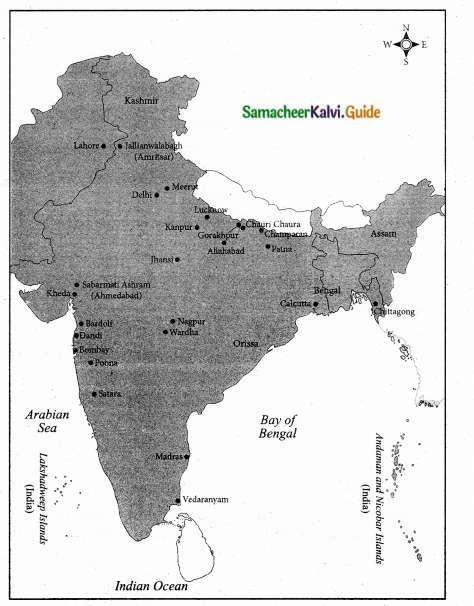
Answer:
Map: Indian National Movement (1900 – 1947)
- Champaran: A Satyagraha campaign conducted against the oppression of the peasants by the Indigo planters.
- Kheda: Gandhi helped to conduct kheda Satyagraha (1918) No – tax provincial struggle by the peasants ended successfully.
- Jallianwala Bagh: Massacre of thousands of people. Nation wide Satyagraha and Vigourously Gandhi enter in to the Indian National Movement.
- Chauri – Chaura: A preocession was conducted as a part of non – cooperation movement. Gandhi advised the participants not to indulge in violence. Violence brokeout Gandhi immediately suspended the movement.
- Calcutta: In a special session the Indian National Congress approved the Non – cooperation movement worked to control Hindu Muslim conflict after the announcement of partition of India, (communal violence)
- Nagpur: Non – Cooperation movement was adopted in the congress session chaired by Salem C. Vijayaraghawachariar.
- Delhi: Gandhi gave his support or khilafat movement by Ali brothers for the cause of Hindu – Muslim unity.
- Allahabad: Khilafat committee adopted Gandhi’s non – violence and non – cooperation programme.
- Madras: Gandhi visited more than 20 times. During his Harijan Tour in Madurai he discard his following robes and wear a simple Dhoti.
- Poona: Gandhi underwent fasting unconditionally against the separate electorates for the depressed classes, (a campaign against untouchability).
- Sabarmathi Ashram: Gandhi set out from Sabarmathi Ashram with 78 followers as a part of Civil Disobedience movement undertook Salt March to defy the levy of tax on salt.
- Lahore: In the All India Congress Session authorised Gandhi to launch the civil disobedience movement.
- Dandi: Gandhi break the salt law by picking up salt from the coast at Dandi. (Dandi March)
- Wardha: Undertook as the Headquarters of Satyagraha. All India villages Industries Association formed Idea of Quit India originated.
- Bombay: Quit India Resolution was passed to end the British rule in India.
![]()
Question 2.
Students can be divided into groups and asked to debate the views of Gandhi, Jinnah, B.R. Ambedkar, Revolutionaries and Communists.
Answer:
(A debate for 5 to 7 minutes)
Step1: Class will be divided in to different groups representing the views of
- Gandhi
- Jinnah
- B.R.Ambedkar
- Revolutionaries
- Communists.
Step 2: From each group one person will be asked to prepare the debate.
Step 3: Debate can be between Gandhi and Jinnah, Gandhi and Ambedkar. Revolutionaries and communists.
Step 4: The students can selects the Character of each (Revolutionary, communist) of their own choice.
Step 5 : The final conclusion on the debate will be compiled and declared by the students as audience.
Step 6: Concluding part can be given by the teacher concerned.
Revolutionaries: Bhaghat singh, Rajguru, Sukhdev, Subhas Chandra Bose, R.K.Dutt.
Communist: Singaravelar, S.A.Dange, P.G. Joshi events for debate points can be taken from Jinnah.
- Boycott of Simon commission Nehru’s report and Jinnah’s response.
- Resignation of Congress Ministries
- Negotiating Independence Simla conference.
- Cabinet mission
- Direct Action day call
- Partition of India.
Gandhi:
- Rowlatt Satyagraha
- Khilafat movement
- Chauri chaura no- tax campaign
- Constructive programme
- Civil Disobedience movement
- Dandi march, left movement in 1930’s
- Partition of India
- Campaign against untouchability
Ambedkar:
- Communal award and poona pact
- Campaign against untouchability
Revolutionaries: Revolutionary Activities
Communists: Left movement in 1930’s.
![]()
Samacheer Kalvi 10th Social Science Nationalism: Gandhian Phase Additional Important Questions and Answers
I. Choose the correct answer
Question 1.
Mohandas Karamchand Gandhi was born on:
(a) 30th October 1896
(b) 26th January 1869
(c) 2nd October 1869
(d) 31st December 1869
Answer:
(c) 2nd October 1869
Question 2.
The language of the educated Indian was ……………
(a) French
(b) English
(c) Hindi
Answer:
(b) English
Question 3.
Gandhi’s experiences in London had not prepared him for:
(a) Injustice
(b) Satyagraha
(c) Services
(d) Racial discrimination
Answer:
(d) Racial discrimination
![]()
Question 4.
The Minto-Morley reforms introduced separate electorate for the …………..
(a) Hindus
(b) Muslims
(c) Sikhs
Answer:
(b) Muslims
Question 5.
After the outbreak of the ……………… Gandhi returned to India.
(a) First world war
(b) Russian revolution
(c) Anglo – Mysore war
(d) Second world war
Answer:
(a) First world war
Question 6.
Bengal was partitioned in ……………….
(a) 1917
(b) 1912
(c) 1905
Answer:
(c) 1905
Question 7.
The real power was not transferred to the Indians as promised by ……………… 1919.
(a) tinkathiya system
(b) Government of India Act
(c) Dyarchy system
(d) Indian council act
Answer:
(b) Government of India Act
Question 8.
Bengal was partitioned by …………..
(a) Lord Ripon
(b) Lord Litton
(c) Lord Curzon
Answer:
(c) Lord Curzon
Question 9
………………… incident made Gandhi to withdraw the no – tax campaign Non – co-operation movement at once.
(a) Bardoli
(b) Champaran
(c) Chauri – chaura
(d) Kheda
Answer:
(c) Chauri – chaura
Question 10.
Home Rule League in Chennai was started by …………..
(a) Tilak
(b) Annie Besant
(c) Nehru
Answer:
(b) Annie Besant
Question 11.
Swarajya party was formed by ………………… and motilal Nehru in 1923.
(a) Madan Mohan Malaviya
(b) C. R. Das
(c) Subhas Chandra Bose
(d) C. Rajaji
Answer:
(b) C. R. Das
Question 12.
Dyarchy was introduced by ………….
(a) Montague Chelmsford Reforms Act
(b) The Charter Act of 1833
(c) 1878 – The Indians Arms Act
Answer:
(a) Montague Chelmsford Reforms Act
Question 13.
The Indian Forest Act of ………………… claimed the original ownership of forests was with the state.
(a) 1878
(b) 1865
(c) 1927
(d) 1972
Answer:
(a) 1878
Question 14.
Gandhiji advocated a new technique in our freedom struggle …………….
(a) Satyagraha
(b) Long march
(c) Violence
Answer:
(a) Satyagraha
![]()
Question 15.
Gandhi called the proposals of ………………… as a post dated cheque on a crashing bank.
(a) Simon commission
(b) Cripps mission
(c) Cabinet mission
(d) Mount Batten plan
Answer:
(b) Cripps mission
II. Fill in the blanks
- The interim Government was headed by :
- ……………….. was sent as viceroy of India with the specific task of transfer of power.
- ……………….. joined the interim Government with some hesitation.
- The mount batten plan was given effect by the enactment of ……………….. by the British parliament.
- ……………….. declared 16th August 1946 as the Direct Action Day.
- The worst affected district in Bengal was ……………….. by communal riots in 1946.
- The Muslim League representative ……………….. was made as the Finance Minister in the Interim Government cabinet.
- According to the mount batten plan boundary commission was set up under ………………..
- Prime Minister of Britain ……………….. wanted to transfer power at the earliest.
- The British surrender in South East Asia to the ……………….. was a big blow to imperial prestige.
- The/British Government arrested the INA officers and put them on trial in the ………………..
- ……………….. formed the provisional Government of free India at Singapore.
- Azad Hindu Faug was organized by ……………….. with Indian prisoners of war with the support of Japanese in Malaya and Burma.
- The Slogan of Quit India Movement given by Gandhiji was ………………..
- ……………….. was the first individual to offer Satyagraha when Gandhi declared limited Satyagraha by individuals.
- The party ……………….. was started by Subhash Chandra Bose after resigned from congress as president.
- In the elections for the provinces in 1937 congress won in ……………….. provinces out of eleven.
- Assam valley Muslim party was led by ……………….. with whom congress formed coalition Government.
- By the Government of India Act of 1935 ……………….. was separated from India.
- In the year ……………….. the ban on the communist party was lifted.
- In 1934 ……………….. was formed by Jaya Prakash Narayan.
- The sudden withdrawal of ……………….. by Gandhi took to violence.
- The communist party established the party in 1928.
- Gandhi started the to work for the removal of discrimination of Harijans.
- The communists used their party as a platform to expose the ………………..
- ……………….. and ……………….. were the leaders of the depressed classes.
- The British Prime Minister ……………….. proposed a federal Government with provincial autonomy.
- ……………….. was the forest area where the police forest and revenue officials harassed the Rampa tribals.
- ……………….. organised the Rampa tribals to fight for their rights.
- A special ……………….. team was sent to quell the uprisings of Rampa Adivasis in 1922-24.
- The soldiers of ……………….. regiment refused to fire on unarmed Satyagraha.
- For defying the salt tax and breaking the salt law Gandhi was arrested at mid night and sent to ……………….. jail.
- The ……………….. event united the different political parties in India.
- As a part of constructive programme Gandhi focussed on promoting ……………….. and made it compulsory for congress man to wear khaddar.
- The prochangers of congress used the ……………….. as a platform for propagation of ………………..
Answers:
- Jawaharlal Nehru
- Lord Mount batten
- The Muslim League
- Indian Independence Act
- Jinnah
- Noakhali
- Liaqut Ali Khan
- RadclifFe brown
- Clement Atlee
- Japanese
- Redfort
- Subhas Chandra Bose
- General Mohan Singh
- Do or Die in the attempt of free India
- Vinobha Bhave
- Forward Bloc
- seven
- Sir Muhammad Sadullah
- Burma
- 1942
- Congress Socialist Party
- Non – cooperation movement
- All India Worker’s and Peasants
- Harijan Sevak Sangh
- True colour British rule in India
- B.R.Ambedkar and M.C Rajah
- Ramsay Macdonald
- Many am
- Alluri Sitarama Raju
- Malabar police
- Gharwali
- Yeravada
- Simon boycott
- khadi
- Legislature, nationalist idea
![]()
III. Choose the correct statement
Question 1.
(i) Prochangers refused to take charge of transferred subjects.
(ii) They did not want to cooperate with the Government.
(iii) They were the staunch followers of Gandhi.
(iv) Some of the Swaraj party members began to accept Government jobs.
(a) (i) and (ii) are correct
(b) (i),(ii), and (iv) are correct
(c) (i) and (iii) are correct
(d) (iii) is correct
Answer:
(b) (i),(ii), and (iv) are correct
Question 2.
(i) In February 1922 Gandhi announced a non – tax campaign in Bengal.
(ii) The nationalist procession at chauri -chaura was provoked by policemen.
(iii) The young leaders of congress thought that the non – cooperation movement was gaining momentum.
(iv) Gandhi continued to conduct the movement at chauri – chaura.
(a) (i) md (ii) are correct
(b) (iii) and (iv) are correct
(c) (ii) and (iii) are correct
(d) (ii) and (iv) are correct
Answer:
(c) (ii) and (iii) are correct
Question 3.
(i) Public meeting was organised at Jailianwala bagh on Baisaki day.
(ii) The only entrance to the park was opened.
(iii) Martial law was imposed in Amritsar after the incident.
(iv) Leaders renounced their titles and honours.
(a) (i) and (ii) are correct
(b) (ii) and (iii) are correct
(c) (ii) and (iv) are correct
(d) (i), (iii) and (iv) are correct
Answer:
(d) (i), (iii) and (iv) are correct
Question 4.
Assertion (A): India became independent on 15th August 1947.
Reason (R): The British parliament passed Indian Independence Act abolishing the sovereignity of British rule over India.
(a) Both A and R are correct and R is the correct explanation of A.
(b) A is correct but R is wrong.
(c) A is wrong R is correct.
(d) Both A and R are correct but R is not the correct explanation of A.
Answer:
(a) Both A and R are correct and R is the correct explanation of A.
![]()
Question 5.
Assertion (A): Cabinet mission suggested a Federal Government and the provinces were divided in to three major groups.
Reason (R): Transfer of power, to elect a constituent Assembly and an Interim Government with representation from ail communities.
(a) A is correct R is wrong.
(b) R is correct A is wrong.
(c) Both A and R are correct R is the correct explanation of A.
(d) Both A and R are correct R is not the correct explanation of A.
Answer:
(c) Both A and R are correct R is the correct explanation of A.
Question 6.
Assertion (A): The British hegemonic control ceased even in the armed forces.
Reason (R): All the political leaders were released and the ban on congress was lifted.
(a) Both A and R is wrong
(b) A is correct R is not the correct explanation of A.
(c) Both A and R are correct R explains A.
(d) Both A and R are correct.
Answer:
(b) A is correct R is not the correct explanation of A.
IV. Match the following
Question 1.
Match the Column I with Column II.

Answer:
A. (iii)
B. (v)
C. (iv)
D. (i)
E. (ii)
Question 2.
Match the colum I with Column II.

Answer:
A. (v)
B. (iv)
C. (ii)
D. (i)
E. (iii)
IV. Answer the following briefly
Question 1.
What were the aims of Indian National Congress?
Answer:
- Greater representation and expansion of legislative councils.
- More facilities for the spread of education.
- Freedom of press
- Holding of India Civil Service Examination in India
- Reduction of military expenditure
- Taxation should be made lighter.
- More Indians should be employed on higher posts.
- Indian council at London should be abolished
Question 2.
What made Gandhi to fight for the rights of the Indians in south Africa?
Answer:
- Gandhi was thrown out of the first class compartment physically on his journey from the Durban to Pretoria, at pietermaritzburg railway station in April 1893.
- Gandhi faced racial discrimination and understood Indians were treated only as coolies.
- He called a meeting of the Indians in Transvaal to form an association to seek redress of their grievances.
- He petitioned to the authorities about the injustices in violation of their own laws.
- Indians had to pay poll tax except in areas marked for them.
- Without permit they could not allowed outdoor after 9 pm.
- These unjust laws made him to fought for the rights of Indians in South Africa.
![]()
Question 3.
Mention the importance of Lucknow session of the Indian National Congress
Answer:
- The moderates and the extremists joined together.
- The Congress and the Muslim League signed a pact agreeing to co-operate with earn “her in order to achieve self government.
- It was at this session Jawaharlal Nehru met Gandhiji for the first time.
Question 4.
What were the programmes included in non – cooperation?
Answer:
The non – cooperation included the following programme.
- Surrender of all titles of honours and honorary offices.
- Non – participation in Government functions.
- Boycott of Government schools, colleges legislature, foreign goods.
- Spreading the doctrine of Swadeshi.
- Suspension of practice by lawyers and settlement of court disputes by private arbitration.
- Refusal to accept any civil or military port.
- Non – participation in Government parties and after official functions.
Question 5.
What were the aims of the Muslim League?
Answer:
Aims of Muslim league:
- To protect the rights of the Muslims.
- To remain loyal to the British Government
- To make a demand for a separate electorate
Question 6.
What were the provisions of Gandhi – Irwin pact?
Answer:
Provisions of Gandhi – Irwin pact:
Gandhi – Irwin pact was signed on 5th March 1931. According to this.
- The British agreed to the demand of all political prisoners not involved in violence.
- Return of confiscated land and lenient treatment of Government employees who had resigned.
- It also permitted the people of coastal villages to make salt for consumption and non – violent picking.
- To suspend the Civil Disobedience movement and attend the second round-table conference.
![]()
Question 7.
What were the changes introduced by the Government of India Act of 1935?
Answer:
- It introduced provincial autonomy.
- It abolished dyarchy in the provinces.
- It established federal government at the centre.
- It provided for the establishment of a federal court to decide the conflicts between the provinces and the centre.
- It provided for the establishment of a Federal Reserve Bank.
VI. Answer all the question given under each caption
Question 1.
Mount Batten Plan
(a) Who was sent as viceroy to India with what task?
Answer:
Mount batten was sent as viceroy to India with the specific task of transfer of power.
(b) When was Mount batten plan announced?
Answer:
Mount batten plan was announced on 3rd June 1947.
(c) On what basis it was planned to transfer power?
Answer:
It was planned to transfer power on the basis of dominion status to India and Pakistan.
(d) What was set up under Raddiffe Brown?
Answer:
Boundary commission was set up under Radcliffe Brown.
Question 2.
The Indian National Congress
(a) When was the Indian National Congress founded?
Answer:
The Indian National Congress was founded in 1885.
(b) On whose advice was it founded?
Answer:
It was founded on the advice of a retired British Civil Servant Allan Octavian Hume.
![]()
(c) Where was the first session of the congress held? Who was the chairperson?
Answer:
- The first session of the congress was held at Bombay.
- W. C. Bannerjee was the chairperson.
(d) Name some of the leaders who attended the first session of the congress.
Answer:
- G. Subramaniam
- Dadabai Naoroji
- Surrendranath Banerjee
- Madan Mohan
- M.G. Ranad
- Gopala Krishna Gokhale
Question 3.
Cabinet Mission
(a) Who sent a Cabinet Mission to India?
Answer:
The British Prime Minister Clement Atlee – (labour party) sent a Cabinet Mission to India.
(b) Who were the members of the Cabinet Mission?
Answer:
Cabinet Mission comprised pethick lawrence, Sir Stafford Cripps and A.V Alexander.
(c) What did the mission reject?
Answer:
The Cabinet mission rejected the demand for Pakistan.
(d) What was the suggested given for transfer of power?
Answer:
It suggested to elect a Constituent Assembly and an Interim Government to be set up with representation for all the communities.
Question 4.
Jallianwala Bagh Tragedy
(a) Who were the prominent leaders Arrested?
Answer:
Dr. Satyapal, and Dr. Saifuddin Kitchlew were arrested.
(b) Where did the people gather?
Answer:
The people gathered in Jallianwala Bagh at Amritsar in Punjab.
![]()
(c) Who was the British military commander of Amirtsar?
Answer:
General Dyer was the British military commander of Amirtsar.
(d) What did Rabindranath Tagore do?
Answer:
Rabindranath Tagore renounced his knighthood.
Question 5.
Congress Ministries and Their Work (1937)
(a) What was the announcement made by the Government of India Act of 1935?
Answer:
The implementation of Government of India Act 1935 announced the elections in 1937.
(b) Who was benefited immensely? How?
Answer:
The congress was benefitted because of the Civil Disobedience movement.
(c) What was the response of congress?
Answer:
The congress called off its programme of boycott of legislature and contested election.
(d) Name some of the measures taken by the congress after forming ministry.
Answer:
Congress ministries responded to the needs of the people. Legislative measures were adopted for reducing the indebtedness of the peasantry and improving the working conditions of the industrial labour.
VII. Answer in detail
Question 1.
Write a paragraph on the Partition of Bengal.
Answer:
- Bengal was partitioned by Curzon in 1905.
- Bengal was partitioned into two parts as East Bengal and West Bengal.
- Curzon made a statement that the partition was purely on administrative grounds.
- But the people of India thought that it was to break the unity of the people and to divide the Muslims from the Hindus.
- The partition angered both the moderates and the extremists.
- They called it as an introduction of the policy of ‘Divide and Rule’ and agitated against it.
- Due to violent criticism and agitation, the partition was revoked in 1911.
- It paved the way for the birth of the Swadeshi movement, an economic boycott.
![]()
Question 2.
What were the movement led by Gandhi towards the struggle for freedom.
Answer:
Gandhi’s Principles was based on Truth and Non – violence.
- He organised the movements adopting the technique of Satyagraha.
- A true Satyagraha will have strong determination and won’t giveup his protest in Ahimsa way and ready to sacrifice his life.
- Three important movements were led by Gandhiji.
- Non – cooperation movement
- Civil Disobedience movement
- Quit India Movement
Non – Cooperation Movement:
Resolution was passed in the Calcutta session of Indian National Congress on September 1920.
No – tax campaign and boycott of foreign goods and institutions were effective.
- At Bardoli in 1922 Gandhi announced no – tax campaign. He made nation – wide tour.
- Thousands joined the movement left their Government jobs. Trade unions and workers actively participated.
- Peasants enhanced Gandhi as a national leader.
- A mass procession was conducted by the peasants at Chauri chaura a village near Gorakhpur (Uttarpradesh) provoked by the police turned in to violence, burnt police station killing 22 policemen.
- Gandhi was upset and suspended non – cooperation movement and abstain himself from the activities of congress for two years.
Civil Disobedience Movement:
Pooma Swaraj was declared by Nehru at Lahore session of congress in 1930.
- 26th January 1930 was declared as Independence day and pledge was taken to attain Pooma Swaraj Non – violently through Civil Disobedience Movement.
- The Indian National Congress authorised Gandhi to launch the movement.
- A charter of demands presented to the viceroy Lord Irwin comply by 31 January 1930, One of the demand was Abolition of Salt tax.
- The viceroy did not respond to the demands Gandhi launched the ‘Civil Disobedience Movement”.
- The inclusion of abolition of salt tax was an tactful brilliant decision.
- Tax on salt affected every section of the society.
- With 78 of his followers Gandhi left Sabarmathi Ashram on 12th March 1930 to Dandi a coastal town to defy salt law.
- Hundreds of people joined the procession .
- At the age of 61 Gandhi covered a distance of 241 miles by foot to reach Dandi in 24 days.
- Reached Dandi on 5th April 1930 at sunset.
- Gandhi took handful of salt from the coast thus breaking the salt law.
- This March was famously known as Dandi March. Gandhi was arrested.
![]()
Quit India Movement:
- The all India congress committee met at Bombay on 8th April 1942 passed famous ‘Quit India Resolution’
- Main reason regarding: transfer of power to Indians failure of cripps mission war* time shortages, price rise,
Gandhi gave a call “Do (or) Die”.
Gandhi said ‘‘We shalTeither .free India or die in the cause attempt: We shall not live to see the perpetuation of our slavery?’.
“Gandhi and other congress leaders were arrested”.
